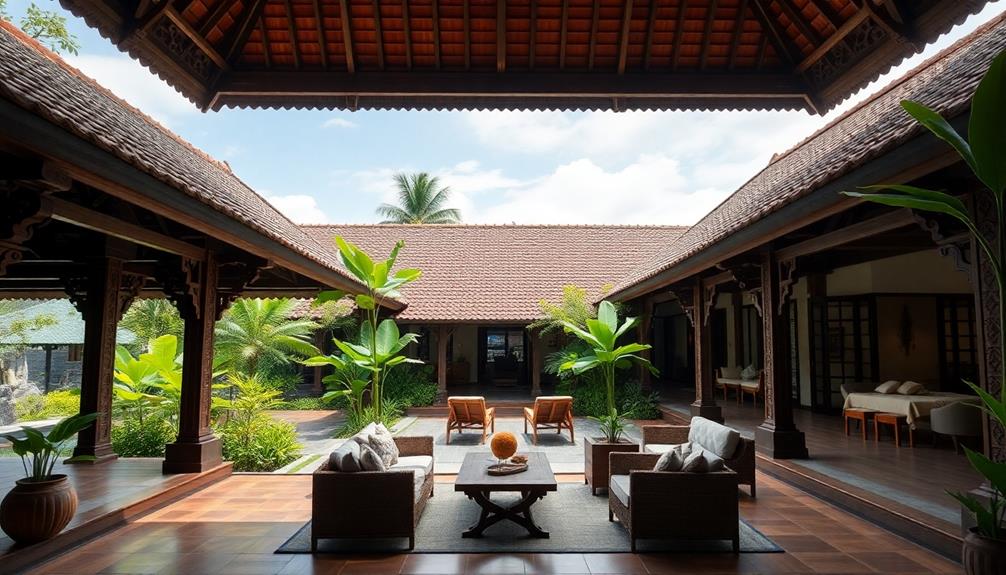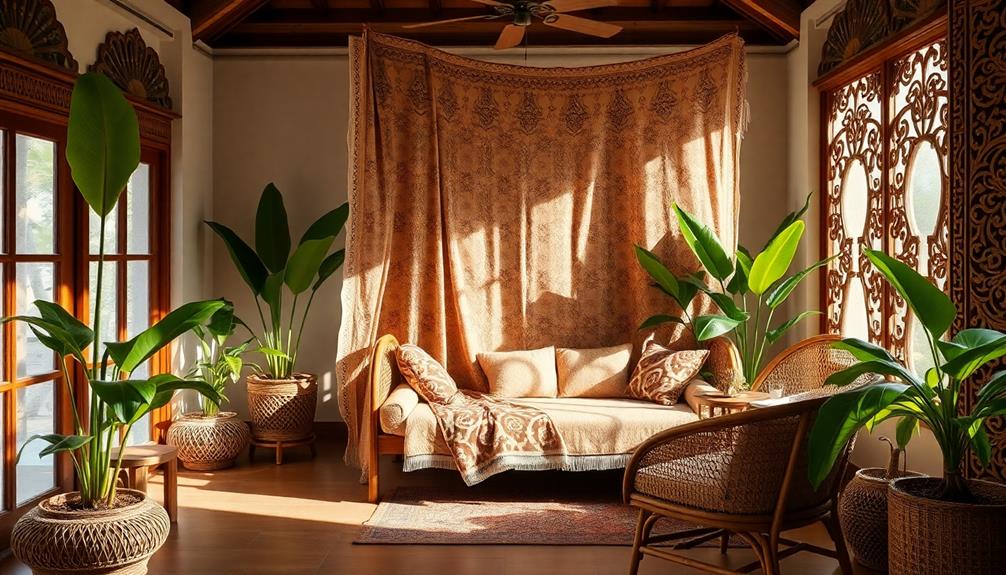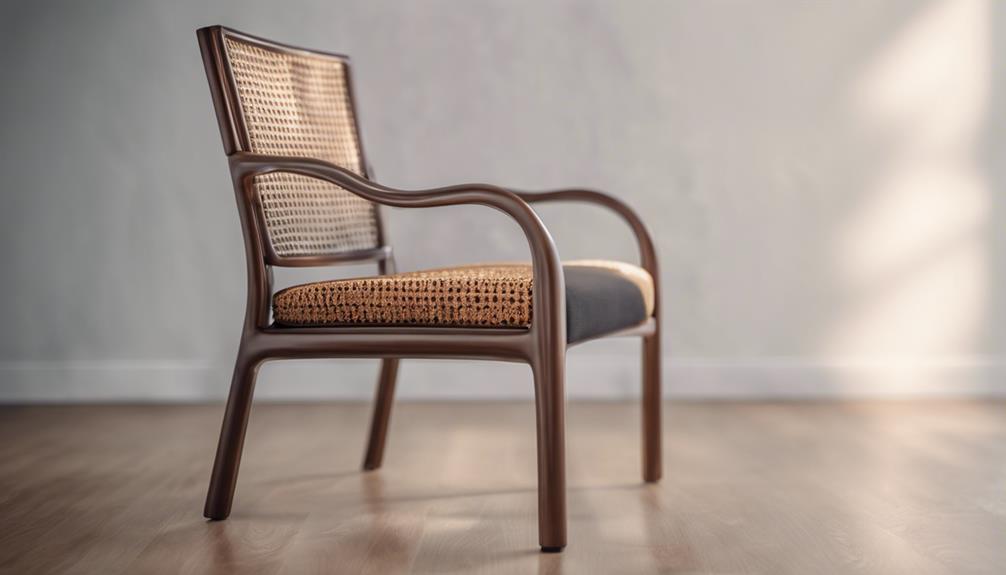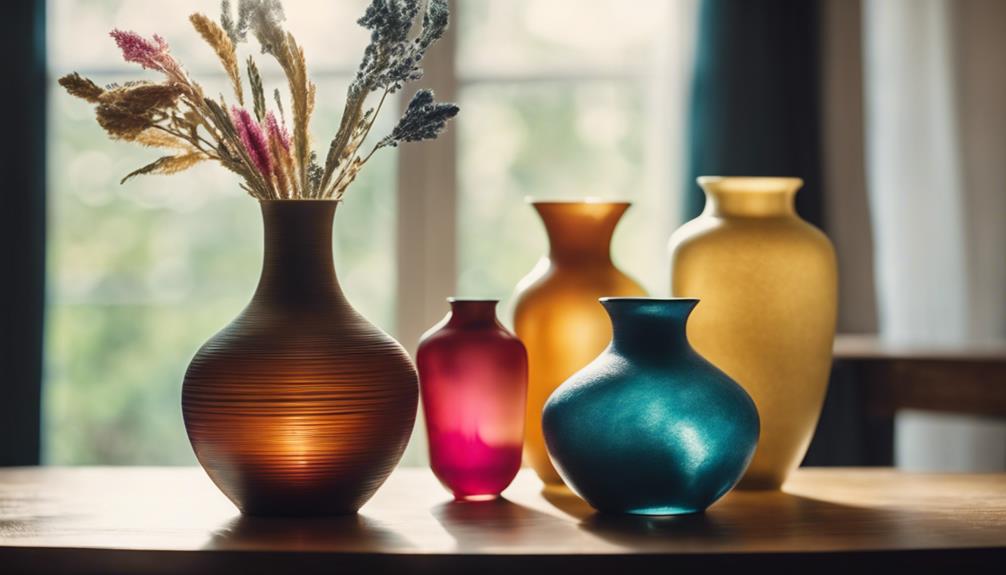Balinese architecture plays a pivotal role in shaping today's Indonesian homes by blending nature with cultural heritage. You'll notice open-air layouts that enhance airflow and light, creating a serene environment. Central courtyards become focal points for family gatherings, reflecting the principles of communal living and spirituality. Modern designs incorporate sustainable materials and eco-friendly practices, mirroring the traditional emphasis on harmony with the environment. These elements not only preserve cultural identity but also cater to contemporary needs. If you explore further, you'll discover more about how this architectural style continues to evolve and inspire new trends.
Key Takeaways
- Balinese architecture promotes open-air layouts and central courtyards, enhancing natural ventilation and outdoor living in modern Indonesian homes.
- The integration of locally sourced materials reflects sustainability and cultural identity, bridging traditional values with contemporary design.
- Principles like Tri Hita Karana influence community-focused developments, fostering harmony among humans, nature, and the divine in urban settings.
- Traditional artistry and symbolism in design elements maintain cultural heritage, enriching the aesthetic and spiritual aspects of contemporary homes.
- An emphasis on eco-friendly practices, such as rainwater harvesting and solar energy, aligns modern living with sustainable lifestyles rooted in Balinese tradition.
Characteristics of Balinese Architecture
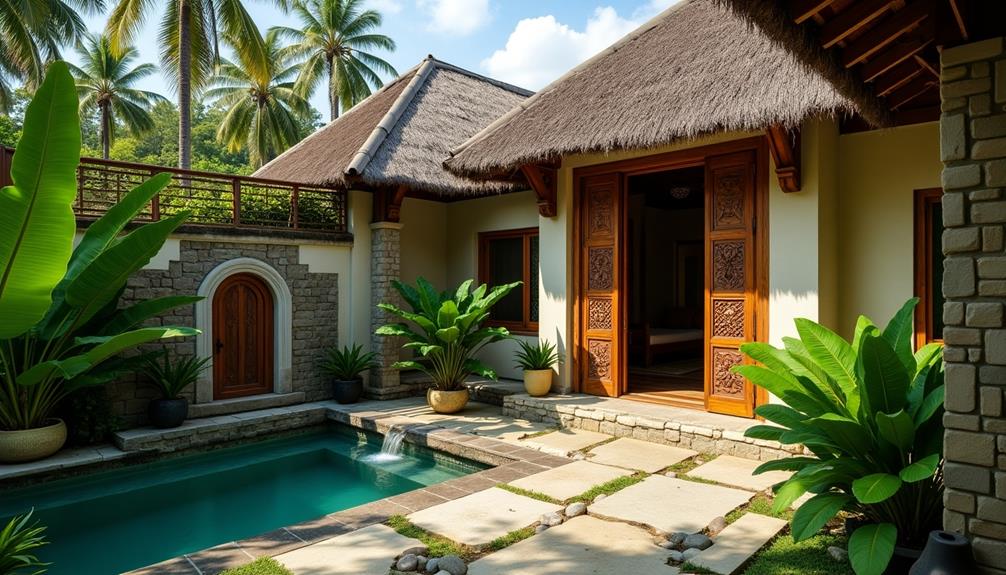
Balinese architecture is renowned for its harmonious integration with the environment, often utilizing natural materials like bamboo, coconut wood, and thatch roofing. This approach allows buildings to blend seamlessly into the lush landscapes, fostering a sense of unity with nature.
The design concepts often emphasize natural materials, along with earth tones and open floor plans that enhance airflow and light. You'll notice that Balinese design emphasizes ornate carvings and intricate details, which often reflect cultural themes and spiritual beliefs. These features enrich the aesthetic appeal of each structure.
A key aspect of Balinese architecture is the Asta Kosala Kosali principles, guiding the spatial organization and functionality of buildings. Typically, homes are designed as compounds with multiple interconnected structures, promoting a communal living environment.
Central courtyards act as focal points, enhancing symmetry and balance while serving as spaces for family gatherings and rituals. Brightly colored tiles and doors punctuate these designs, symbolizing various cultural aspects and adding vibrancy.
Each element contributes to a harmonious relationship between the buildings and their surroundings, creating an inviting atmosphere. By understanding these characteristics, you can appreciate how Balinese architecture not only showcases beauty but also embodies cultural significance.
Cultural Influences on Design
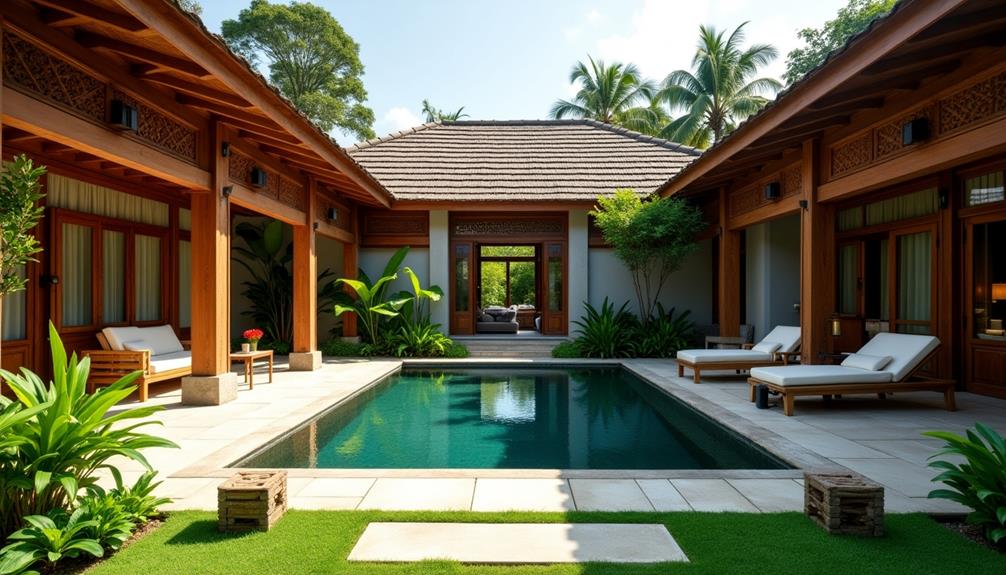
In many ways, the cultural influences on design in Balinese architecture reflect the island's rich spiritual heritage and communal values.
You'll notice that traditional Balinese houses aren't just structures; they embody a deeper cultural significance that integrates spirituality and daily life. The principles of Tri Hita Karana, which emphasize harmony among humans, nature, and the divine, play a vital role in shaping these designs. This philosophy guides the layout and orientation of homes, guaranteeing that they foster a connection with the environment and the community.
Additionally, elements like Indonesian decorative pillows can be incorporated to enhance the aesthetic and comfort of living spaces, further celebrating the rich cultural tapestry of Indonesia.
As you explore Balinese architecture, you'll find intricate carvings and statues that depict deities like Shiva, Vishnu, and Brahma. These elements are more than ornamental; they convey symbolic meanings rooted in spiritual beliefs and cultural narratives.
Daily offerings placed around homes and temples further highlight this integration of spirituality into everyday life. Even in modern Indonesian homes, you'll see the incorporation of Balinese architectural elements, showcasing a blend of cultural identity with contemporary needs.
This enduring influence guarantees that the essence of Balinese architecture continues to resonate, reflecting a vibrant cultural legacy in today's designs.
Principles of Balinese Architecture
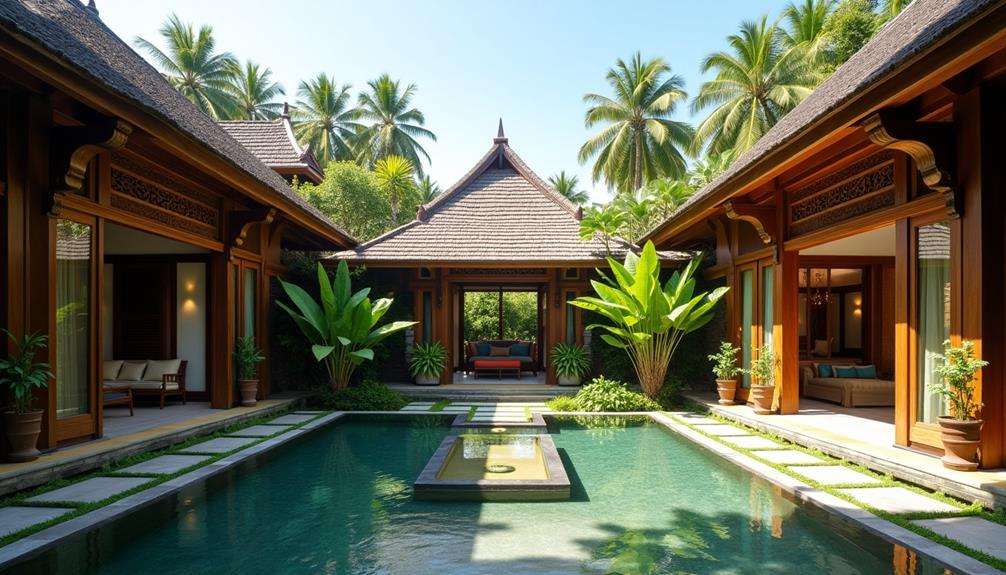
When you explore Balinese architecture, you'll find a deep connection to nature and spirituality at its core.
The principles of harmony with nature and spiritual design shape every aspect of these homes, creating spaces that reflect balance and tranquility.
This architectural style emphasizes open-air layouts and the use of natural materials, which enhances the feeling of serenity and promotes outdoor living.
Understanding these guiding concepts can enhance your appreciation of this unique architectural style, especially the focus on tropical villa plans that celebrate natural light and local materials.
Harmony With Nature
Harmony in architecture isn't just about aesthetics; it's a profound connection with nature that defines Balinese homes. In Balinese traditional architectural designs, you'll notice the use of natural materials like bamboo, coconut wood, and thatch roofing. These choices promote harmony with the environment and minimize ecological impact, allowing your home to blend seamlessly into its surroundings.
Additionally, the incorporation of traditional artistry in decor, such as vibrant Indonesian masks, enhances the cultural significance of these spaces.
The principles of Asta Kosala Kosali guide how buildings are arranged, ensuring they align with both spiritual and environmental harmony. Central courtyards are common in these designs, acting as focal points that enhance air circulation and light flow while providing a serene outdoor space for family gatherings. This layout encourages a connection to nature, inviting the outdoors in.
The Tri Hita Karana philosophy further emphasizes balance among the divine, human, and natural domains, influencing the orientation of structures to create a harmonious living environment.
Balinese traditional houses are often designed as compounds, integrating living spaces with gardens that reflect the lush tropical landscape. This design fosters a unique relationship between the occupants and their natural surroundings, making your home a true sanctuary.
Spiritual Design Principles
Balinese architecture is deeply rooted in spiritual design principles that create a unique connection between the physical and the divine. These principles guide not just the aesthetic but also the functional aspects of homes, fostering harmony in daily life.
At the core of this design philosophy lies Tri Hita Karana, which emphasizes balance among the divine (Parahyangan), humans (Pawongan), and the environment (Palemahan). This approach is reflected in the modern tropical aesthetics in Bali, where natural materials and open spaces enhance the connection to nature.
Key elements of spiritual design principles include:
- Tri Mandala: This concept organizes space into three domains—Nista Mandala (outer), Madya Mandala (middle), and Utama Mandala (inner)—each serving unique spiritual and functional purposes.
- Asta Kosala Kosali: These guidelines dictate the orientation and layout of buildings to align with sacred directions, promoting positive energy flow.
- Symbolic Carvings and Sculptures: Intricate designs reflect cultural heritage and religious beliefs, reinforcing the connection between the physical and spiritual domains.
Modern Adaptations of Traditional Elements
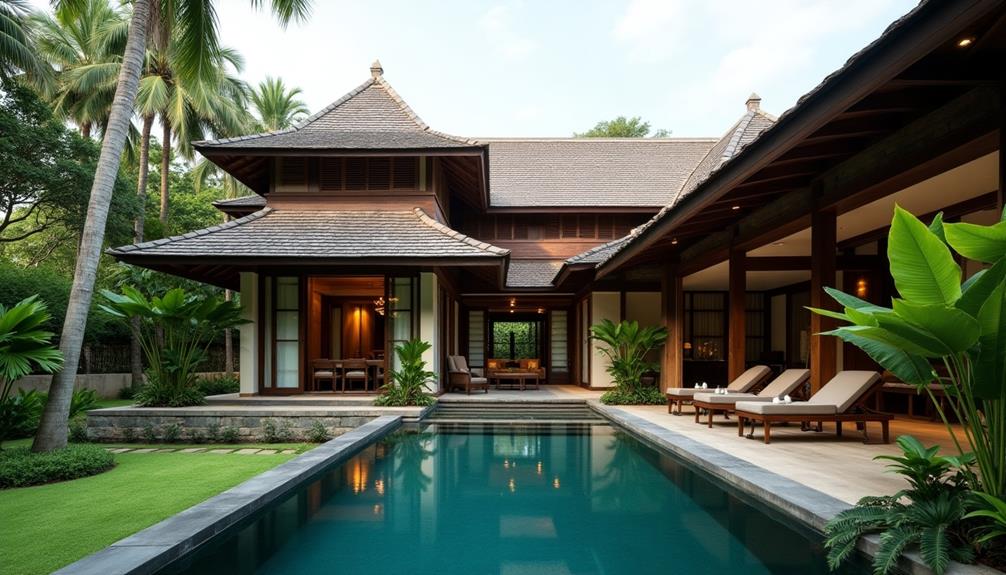
Incorporating traditional Balinese architectural elements into modern Indonesian homes has become a popular trend, enhancing both aesthetic appeal and functionality.
You'll notice that many modern Balinese designs embrace open-air layouts and courtyards, allowing for natural ventilation and a seamless connection between indoor and outdoor spaces. This approach not only improves airflow but also invites nature into your living environment, creating a harmonious atmosphere that reflects traditional Indonesian style home decor.
Contemporary homes often utilize locally sourced materials like teak wood and natural stone, reflecting a commitment to sustainability while maintaining the charm of Balinese culture.
The rich ornamentation and intricate carvings that adorn doorways and wall features pay homage to Balinese artistry, preserving cultural heritage in a modern context.
Moreover, many residences adopt the Tri Hita Karana philosophy, which emphasizes harmony among the divine, residents, and nature. This mindset influences spatial organization and overall design, creating a tranquil living atmosphere.
Finally, modern Balinese homes increasingly embrace eco-friendly practices like rainwater harvesting systems and solar panels, aligning traditional values with contemporary environmental concerns.
Significance in Contemporary Indonesia
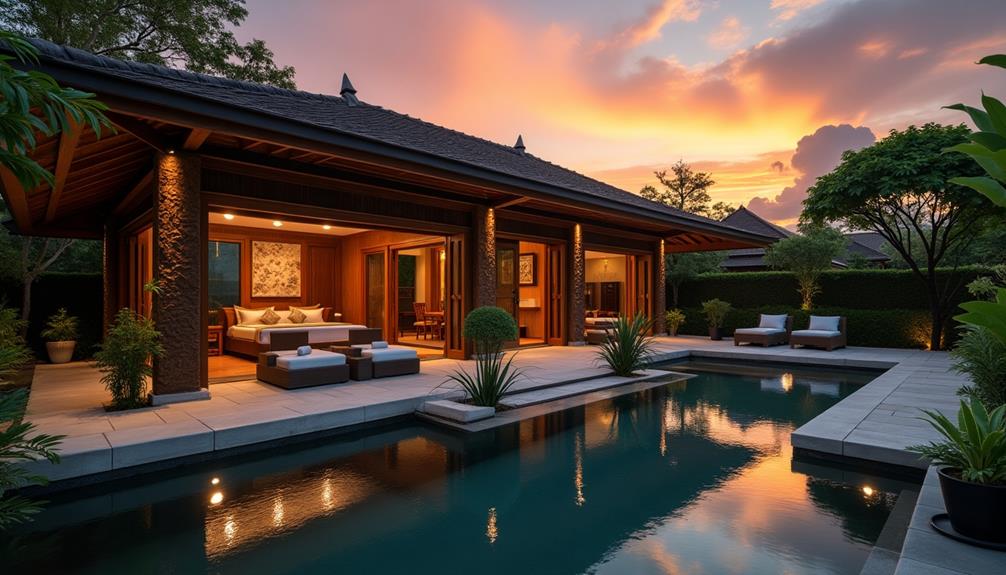
In contemporary Indonesia, you'll notice how Balinese architecture plays an essential role in preserving cultural heritage while introducing modern design innovations.
This architectural style, characterized by its intricate carvings and open spaces, reflects the spiritual connection to nature that's paramount in Balinese culture.
This blend not only enhances aesthetic appeal but also promotes sustainable living practices that resonate with today's eco-conscious mindset, as seen in traditional Indonesian housing.
As you explore these homes, you'll see how tradition and modernity come together to create spaces that reflect both history and innovation.
Cultural Heritage Preservation
Cultural heritage preservation plays an essential role in shaping contemporary Indonesian identity, especially as globalization influences everyday life.
Balinese architecture stands out as a cultural emblem, reflecting Indonesia's rich heritage and spirituality. By integrating traditional elements into modern homes, you help maintain the Balinese cultural identity while meeting contemporary needs. This integration can be seen in various decorative elements, such as the Face Indonesian Decor Mask, which not only enhances interior aesthetics but also fosters a deep appreciation for traditional craftsmanship.
Here are a few key aspects of cultural preservation in architecture:
- Sustainable Living: Architectural principles like Tri Hita Karana and Asta Kosala Kosali promote harmony with nature, encouraging eco-friendly practices.
- Cultural Appreciation: The ornate carvings and vibrant colors of Balinese designs enrich modern aesthetics, fostering an appreciation for Indonesia's artistic heritage.
- Community Pride: Initiatives focused on preserving Balinese styles instill a sense of pride and connection to cultural roots, guaranteeing future generations understand their heritage.
As you embrace these architectural principles, you not only enhance your living space but also contribute to a broader movement that honors Indonesia's rich cultural landscape.
In doing so, you help guarantee that Balinese heritage remains alive and relevant amidst the rapid changes of the modern world.
Modern Design Innovations
Modern design innovations in Indonesia greatly blend traditional Balinese elements with contemporary aesthetics, creating homes that resonate with both beauty and functionality.
You'll notice that many modern Indonesian homes feature open floor plans that enhance space and promote airflow, essential for the tropical climate. The integration of expert consultation for tropical living spaces has become increasingly popular, emphasizing the importance of both functionality and aesthetic appeal.
The use of natural materials like ironwood and locally sourced stone not only adds high-quality finishes but also reflects a commitment to eco-friendly practices while preserving cultural identity.
Expansive open windows and seamless shifts to gardens foster a harmonious relationship with nature, a core principle of Balinese architecture. You'll find that these designs often include artistic elements and intricate carvings that pay homage to traditional Balinese styles, enriching the cultural significance of modern residential architecture.
The trend toward compact luxury homes and tiny houses in Bali's real estate market highlights a growing interest in minimalism and efficiency, inspired by traditional Balinese spatial organization.
Sustainable Living Practices
How can sustainable living practices reshape contemporary Indonesian homes? By embracing locally sourced materials like bamboo poles and coconut wood, you're not only reducing your environmental impact but also staying true to traditional Balinese architecture.
Incorporating elements from Indonesian wedding decor ideas, such as intricate wooden carvings and vibrant color palettes, can also enhance the aesthetic of sustainable homes. Integrating natural ventilation and open-air designs in your home can minimize reliance on air conditioning, making your space more eco-friendly and energy-efficient.
Consider these sustainable living practices:
- Rainwater harvesting systems: Capture rainwater for daily use, reducing water waste.
- Solar panels: Harness renewable energy, decreasing dependency on nonrenewable resources.
- Community initiatives: Join local conservation efforts that promote both natural resource preservation and cultural heritage.
The rise of tiny homes and compact luxury villas in Bali highlights a shift toward minimalist living that prioritizes sustainability.
These homes reflect a commitment to self-sufficiency, blending modern comforts with eco-friendly practices. By adopting these sustainable living practices, you can foster a sense of identity and environmental stewardship while contributing to a healthier planet for future generations.
Integrating Nature and Sustainability
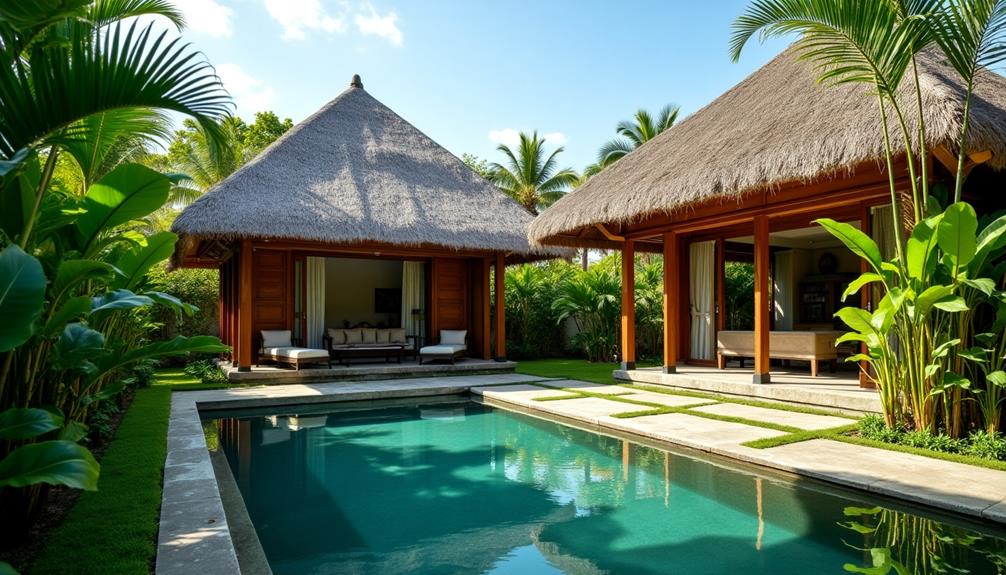
Embracing nature in Balinese architecture not only enhances the aesthetic appeal of Indonesian homes but also fosters sustainability. By using locally sourced natural materials like bamboo, teak, and thatch, you can minimize environmental impact while creating a warm and inviting living room.
The Balinese people have perfected open-air designs that promote extensive natural ventilation, reducing reliance on air conditioning and aligning with eco-friendly practices suited to the tropical climate.
Integrating water features such as ponds and fountains into your garden not only symbolizes fertility but also enhances the serene atmosphere, connecting indoor and outdoor spaces seamlessly.
You'll find that incorporating lush greenery and native plant species fosters biodiversity, enriching the ecological balance in your home environment.
Additionally, opting for durable materials like Jogja stone and ironwood guarantees longevity, reducing maintenance needs and supporting a sustainable lifestyle.
As you design your home, consider these elements that reflect Balinese principles. By integrating nature and sustainability, you'll create a harmonious living space that resonates with both beauty and ecological responsibility.
Influences on Future Architectural Trends
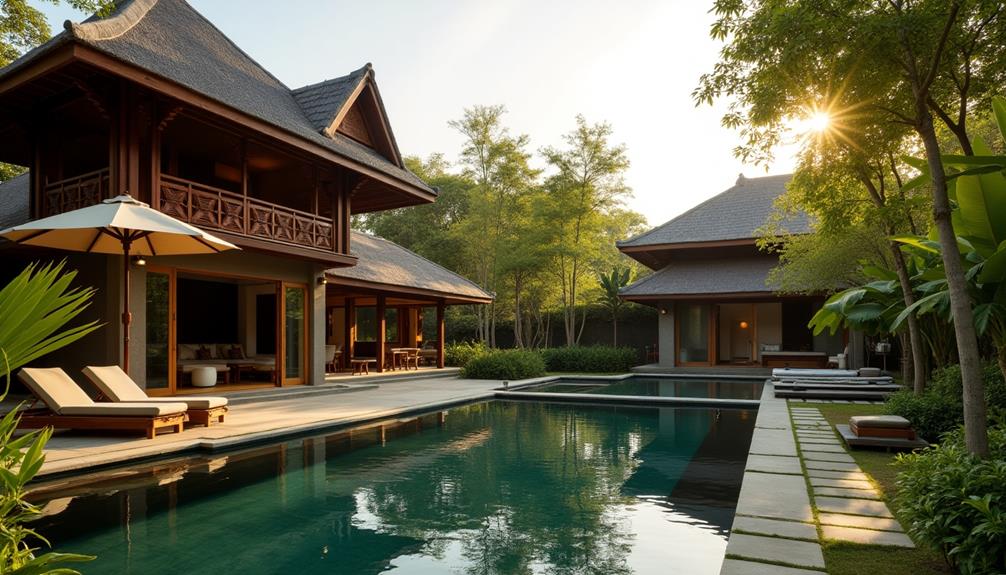
As you explore the principles of Balinese architecture, you'll notice their lasting impact on future architectural trends in Indonesia. This influence drives a shift towards sustainability, with a growing emphasis on eco-friendly materials like bamboo and recycled resources. The integration of these materials reflects a deep-seated connection to nature, echoing traditional Balinese values.
Key influences on future architectural trends include:
- Spatial hierarchy: Modern designs will prioritize functionality and spiritual harmony, aligning with the principles of Asta Kosala Kosali.
- Community-focused developments: Inspired by the Tri Hita Karana philosophy, architects will create spaces that foster harmony among humans, nature, and the divine.
- Open-air living: As urbanization increases, incorporating natural ventilation and outdoor spaces will be essential for comfortable, climate-responsive homes.
Frequently Asked Questions
What Is Modern Balinese Architecture?
Modern Balinese architecture blends traditional elements with contemporary design. You'll find open spaces, natural materials, and eco-friendly practices, all fostering a strong connection to nature, while emphasizing comfort and cultural identity in harmonious living environments.
What Is the Balinese Architecture Culture?
Isn't it fascinating how Balinese architecture embodies a culture deeply rooted in spirituality and nature? You'll discover its unique harmony, intricate designs, and community-oriented layouts, reflecting an enduring relationship between people, their environment, and sacred beliefs.
What Are the Principles of Balinese Architecture?
Balinese architecture principles focus on harmony, emphasizing the Tri Mandala concept to organize space spiritually. You'll find interconnectedness through Tri Hita Karana, fostering balance among humans, nature, and the divine in every design.
What Three Elements Does Traditional Balinese Architecture Seek to Balance?
Imagine a dance between nature, humanity, and the divine. Traditional Balinese architecture seeks to balance Parahyangan, the sacred; Pawongan, the people; and Palemahan, the environment, creating harmony that resonates deeply within the community's spirit.
Conclusion
As you explore the beauty of Balinese architecture, can you imagine living in a space where nature and tradition intertwine seamlessly? Today's Indonesian homes reflect this rich heritage, showcasing sustainable designs that honor the past while embracing modernity. By integrating traditional elements, you'll find that these homes not only provide comfort but also connect you to the vibrant culture of Indonesia. The future of architecture lies in this harmonious blend, inviting you to be part of a lasting legacy.
